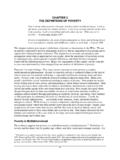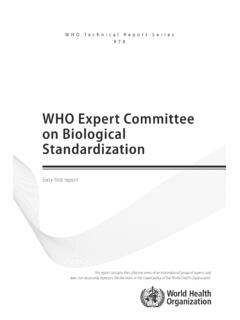Transcription of The FRESH M&E Framework - World Bank
1 The FRESH M&E Framework A Generic Framework for Monitoring and Evaluation of School Health Interventions Draft-Version Updated 20 November 2010. Acknowledgements Following the meeting of FRESH partners in September 2008, the FRESH M&E coordinating group has coordinated the development of this M&E Framework with the assistance of numerous individuals, organizations and countries. The FRESH M&E coordinating group members who have contributed to the development of this Framework have included: Michael Beasley and Kristie Neeser from Partnership for Child Development; Natalie Roschnik and Mohini Venkatesh from Save The Children; Ramya Vivekanandan from UNESCO; Anna Maria Hoffman from UNICEF; Giovanna Campello and Katri Tala from UNODC; and Kwok Cho Tang from WHO.
2 This draft version was prepared by Abigail Kaplan Ramage (independent consultant). We are thankful to the FRESH M&E advisory group for supporting the development of the Framework , and for their valuable input received during the process. The advisory board is comprised of all FRESH partners. In particular, we would like to thank the following individuals/ organisations: Carmen Aldinger (Education Development Center), Christiana Brown (Child-to-Child Trust, Institute of Education), Donald Bundy (School Health and Nutrition, The World Bank), , Lesley Drake (Deworm the World / Partnership for Child Development), Nancy Walters (UN World Food Programme), Seung-hee F.
3 Lee (Save the Children), Kathleen Letshabo (UNICEF), Yong Feng Liu (Division for the Coordination of UN Priorities in Education, Section on HIV. and AIDS, UNESCO) Pamela Sabina Mbabazi (Control of Neglected Tropical Diseases, WHO), and Chandra-Mouli Venkatraman (Adolescent Health and Development, WHO). We would also like to thank the following individuals who provided their time and input in to the Framework document: Aulo Gelli (PCD); Rick Davis ( ); Murat Sahin (WASH/UNICEF), David Osher, Elizabethe Spier and Cheryl Vince Whitman (American Institutes for Research), Simon Brooker (KEMRI, LSHTM), and Matthew Jukes (Harvard School of Education).
4 2. Abbreviations and Acronyms AIR American Institutes for Research AIDS Acquired Immune Deficiency Syndrome CFSs Child Friendly Schools ECD Early Childhood Development EMIS Education Management Information System FRESH Focusing Resources on Effective School Health HIV Human Immunodeficiency Virus IATT Inter-Agency Task Team on Education IRS Indoor residual spraying ITN Insecticide-treated net LLIN Long-lasting insecticidal net MoE Ministry of Education MoH Ministry of Health NTD Neglected Tropical Diseases PCD Partnership for Child Development PTA Parent Teachers Association SCN Standing Committee on Nutrition SEL Social and Emotional Learning STI Sexually Transmitted Infection UNESCO United Nations Educational, Scientific and Cultural Organization UNICEF United Nations Childrens Fund UNODC United Nations Office of Drugs and Crime UPC Universal Primary Completion WASH Water, Sanitation and Hygiene WFP World Food Programme WHO World Health Organization 3.
5 TABLE OF CONTENTS. EXECUTIVE SUMMARY ..6 BACKGROUND ..9 FRESH Background .. 9 Development of the M&E Framework .. 10 Core Framework for action .. 11 Cross Cutting Themes .. 13 Audience .. 14 THE Framework .. 15 Purpose of the M&E Framework .. 15 Guiding principles .. 15 Components of the Framework .. 15 TOOLS AND METHODS .. 16 FRESH SUMMARY INDICATORS .. 18 POLICIES .. 19 1. Existence of a national level policy that addresses school health across all four components of FRESH .. 20 2. Extent to School Health Policy is Implemented Across the Country.
6 22 Environment .. 23 3. Existence of national level school environment (inspection) standards .. 24 4. Percentage of schools implementing physical school standards .. 27 5. Existence of national level psychosocial school environment standards .. 28 6. Percentage of schools implementing the psychosocial school standards .. 29 SERVICES .. 30 7. Percentage of schools that provide health and nutrition services with referral to treatment systems .. 31 SKILLS BASED HEALTH EDUCATION .. 32 8. Life skills concepts and themes are addressed in the national curricula for primary and secondary schools.
7 33 9. Life skills concepts and themes are explicitly assessed in national examination systems at various levels of education .. 35 10. Life skills concepts and themes are addressed in the pre service teacher training curricula .. 36 11. Percentage of learners that have received life skills education in the last academic year .. 37 12. Percentage of teachers having received in service training in life skills education in the last academic year .. 38 13. Percentage of women and men, aged 15 49 years, who had more than one partner in the past 12 months who used a condom during their last sexual intercourse (UNGASS #17).
8 39 14. Current school attendance among orphans and non orphans, aged 5 17 years (From Revised IATT, reformulation of UNGASS#12).. 40 15. Percentage of women and men, aged 15 20 years, who had more than one partner in the past 12 months who used a condom during their last sexual intercourse (From Revised IATT,UNGASS #17) .. 41 FRESH THEMATIC INDICATORS .. 42 Thematic Indicator 1: HIV/AIDS .. 43 Thematic Indicator 2: Deworming (Neglected Tropical Diseases Controlled) .. 46 Thematic Indicator 3: Hygiene, Water Supply and Sanitation .. 52 Thematic Indicator 4: Malaria.
9 56 4. Thematic Indicator 5: Nutrition .. 61 Thematic Indicator 6: Education for Sustainable Development .. 66 Thematic Indicator 7: Sexual and Reproductive Health .. 68 Thematic Indicator 8: Physical Activity .. 69 Thematic Indicator 9: Oral Heath, Vision and Hearing .. 71 Thematic Indicator 10: Social Emotional Learning/Generic Life Skills .. 72 Thematic Indicator 11: Substance Abuse .. 74 Thematic Indicator 12: Disaster Risk Reduction and Emergencies .. 76 Thematic Indicator 13: Violence In the School Setting .. 79 Thematic Indicator 14: Prevention and Response to Unintentional Injuries.
10 82 Thematic Indicator 15: Children with Special Needs .. 83 ANNEX A .. 84 Participatory Weighted Checklists .. 84 ANNEX B .. 90 AIR/ UNICEF Child Friendly School Scales .. 90 ANNEX C .. 93 Discussion with AIR on Use of Scales .. 93 ANNEX D .. 96 Assessment Checklists for water, hygiene and sanitation .. 96 ANNEX E .. 99 HIV/AIDS National Composite Policy Index .. 99 5. Executive Summary Purpose of the M&E Framework The purpose of the FRESH1 monitoring and evaluation (M&E) Framework is to provide guidance to countries or organizations implementing school health programmes in selecting indicators from internationally agreed sources to monitor and evaluate their programmes.















